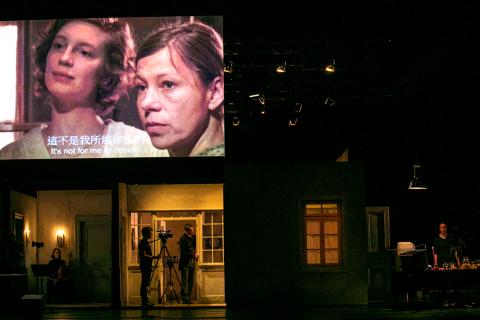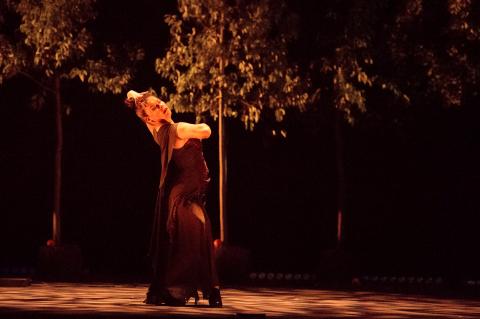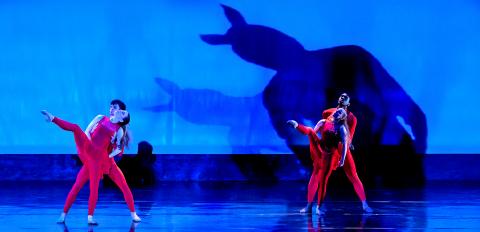For theater and film buffs, British director Katie Mitchell’s production of Miss Julie for Berlin’s Schaubuhne theater at the National Theater last weekend was a treat.
Mitchell’s retelling of Swedish author and playwright August Strindberg’s 1888 classic one-act play about class, gender and rebellion focuses on a behind-the-scenes view of Miss Julie, servant Jean and Kristen, the cook and Jean’s fiancee.
Not only does she tell the story through Kristen’s eyes and ears, the audience sees the action from behind doors and through windows as well, as live theater is combined with video footage, both live and prerecorded, helped by Leo Warner’s film direction.

Photo: Courtesy of Chou Chia-Hui / NTCH
The set is a mix of walls, windows and doors — with the walls moved back and forth to create small rooms, corridors, outdoor walkways — as well as two sound booths, props and shelving and a table where the sound foley crew of Maria Ueberschaer and Lisa Guth work their magic so that the audience can hear what Kristen and the other actors are doing.
In addition to Jule Bowe as Kristin, Tilman Strauss as Jean and Luise Wolfram as Miss Julie, the audience could watch Cathlen Gawlich as Kristen’s double, camera operators Andreas Hartmann and Krzysztof Honowski and cellist Gabriella Strumpel.
Everybody helps out. When not required for a scene, the actors help the film crew shift the walls, cameras and lighting equipment. It is a modern-day take on Strindberg’s stage directions that everything in a performance is done as naturally as possible.

Photo: Chang Chen-chou / NTCH
Mitchell does not tackle the entire play; she takes it as a given that the audience knows the basic story outline so she can focus on the small, everyday things, with the video providing an intimacy that usual stage productions cannot give.
In the videos, the audience sees Kristen washing and slicing a kidney for Jean’s meal and later serving it to him with extra helpings of gravy, or using a glass pressed to the floorboards to listen to a fight between Miss Julie and Jean in the room below — actions that would have otherwise been hidden by the set walls or too far away for most audience memebers to see.
The dialogue was minimal, with surtitles projected as part of the video, and the acting restrained.

Photo: courtesy of Bill Naimann
The overall effect of Mitchel’s vision was beautiful, and for those who are interested in the technical side of stage and movie productions, seeing it was a delight akin to being a child let loose in a sweet shop. However, like sweet shops, the visual stimulation in the end was overwhelming: There was just so much to look at that in the end you feared that you might have missed the best bits.
The visual delights of Miss Julie, brought to the National Theater as part of the Taiwan International Festival of Arts, were equaled the preceding weekend by another program in the festival’s line-up, the Rocia Molina Company’s Bosque Ardora.
Conceived by, directed by and starring Molina, the production promised something more than the usual flamenco show and it delivered.
The show opens with a beautiful short film of nature — beautifully colored dawn sky, verdant trees, a lake or river, insects and animals into which the baying sounds of hunting dogs and a galloping horse’s hoofs can gradually be heard.
Then glimpses of a horse and female rider; the hunted or the hunter? There is no way to tell before the rider, Molina, is unceremoniously dumped into the water by her horse, which gallops off.
The screen rises to the sounds of dripping water and the crouching figure of Molina is seen on tree-laden stage dressed as the rider, but with a fox’s head mask on her forehead.
Carlos Marquerie’s terrific lighting gives the scene a dreamlike quality as Molina shifts from animal-like crawls and stretches to more human moves, beginning her story that mixes Greek mythology with Spanish flair.
Molina is always captivating, whether portraying a fox, a goddess, a hunter or a seductress — or tottering on her heels in a “morning-after” sequence that drew comparisons with Charlie Chaplin’s physical comedy. One very short solo performed facing guitarist Eduardo Trassierra — who was terrific — was worth the price of admission alone.
Molina was more than even matched by Eduardo Guerrero and Fernando Jimenez, who really did not have that much to do until a great solo toward the end for Jimenez.
Kudos also to guitarist Eduardo Trassierra, Pablo Martin Jones on drums, Jose Vicente Ortega and Agustin Orozco on trombone and Maria Karolina Gonzalez Martinez for her “Palmas y Compas, ” but I was less impressed with singer Jose Javier Guerrero Hernandez.
The show ended as it began, with a hunter and fleeing prey, only unlike the opening video, the prey does not escape.
While Molina and crew were delighting audiences in the main theater, upstairs in the Experimental Theater, Body Expression Dance Theatre (BodyEDT, 體相舞蹈劇場) and the Cleveland, Ohio-based Verb Ballets were performing their Mix+Multi Arts Festival program, which turned out to be a mixed bag indeed.
The performance that I saw featured three works performed by the US dancers, Anthony Krutzkamp’s Appropriated Memories, Daniel Precup’s duet Ne me quitte pas and Body EDT director Lee Ming-cheng’s (李名正) The Arrival of Departure, followed by Lee’s latest work, Initial — space starting (空間起點) performed by his company.
Appropriated Memories was performed by all eight Verb Ballets dancers, paired into four couples. While not an especially memorable piece, it was pleasant, with lots of great lifts and a tender duet, performed at the show I saw by Christina Lindhout and Stephan Hood, who were great.
Kate Webb and Michael Hinton were terrific in Ne me quitte pas, a short and sweet piece inspired by and set to Jacques Brel’s song by the same name.
I was less taken with Lee’s two works, which relied on computer-generated projections for their visual impact, which was too bad since I am usually a fan of Lee’s, and too often the projections were more interesting than the dancers. Verb Ballets’ dancers gave The Arrival of Departure their best effort, but the piece, with a lot of Lee’s usual insect-like floorwork, did not play to their strengths.
However, at least the visuals and the dancing seemed to go together for Initial — space starting, giving the impression of travelers moving through vortexes, but the overall lighting for the work often left the dancers largely in the dark.

April 14 to April 20 In March 1947, Sising Katadrepan urged the government to drop the “high mountain people” (高山族) designation for Indigenous Taiwanese and refer to them as “Taiwan people” (台灣族). He considered the term derogatory, arguing that it made them sound like animals. The Taiwan Provincial Government agreed to stop using the term, stating that Indigenous Taiwanese suffered all sorts of discrimination and oppression under the Japanese and were forced to live in the mountains as outsiders to society. Now, under the new regime, they would be seen as equals, thus they should be henceforth

Last week, the the National Immigration Agency (NIA) told the legislature that more than 10,000 naturalized Taiwanese citizens from the People’s Republic of China (PRC) risked having their citizenship revoked if they failed to provide proof that they had renounced their Chinese household registration within the next three months. Renunciation is required under the Act Governing Relations Between the People of the Taiwan Area and the Mainland Area (臺灣地區與大陸地區人民關係條例), as amended in 2004, though it was only a legal requirement after 2000. Prior to that, it had been only an administrative requirement since the Nationality Act (國籍法) was established in

With over 80 works on display, this is Louise Bourgeois’ first solo show in Taiwan. Visitors are invited to traverse her world of love and hate, vengeance and acceptance, trauma and reconciliation. Dominating the entrance, the nine-foot-tall Crouching Spider (2003) greets visitors. The creature looms behind the glass facade, symbolic protector and gatekeeper to the intimate journey ahead. Bourgeois, best known for her giant spider sculptures, is one of the most influential artist of the twentieth century. Blending vulnerability and defiance through themes of sexuality, trauma and identity, her work reshaped the landscape of contemporary art with fearless honesty. “People are influenced by

Three big changes have transformed the landscape of Taiwan’s local patronage factions: Increasing Democratic Progressive Party (DPP) involvement, rising new factions and the Chinese Nationalist Party’s (KMT) significantly weakened control. GREEN FACTIONS It is said that “south of the Zhuoshui River (濁水溪), there is no blue-green divide,” meaning that from Yunlin County south there is no difference between KMT and DPP politicians. This is not always true, but there is more than a grain of truth to it. Traditionally, DPP factions are viewed as national entities, with their primary function to secure plum positions in the party and government. This is not unusual